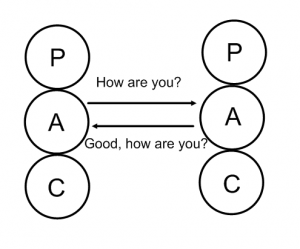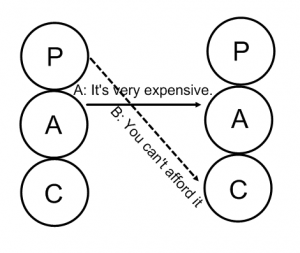 Now I want to start this post by saying your boss isn’t all bad, I mean we are in the land of I’m OK, you’re OK right? But it has to be said, sometimes (s)he does go on a bit! So it’s only right that we help out and save a bit of time by trimming the conversation somewhat. I’m sure you get my drift! Transactional analysis is not called that for nothing. When we look at how two people are communicating and breaking it down into each single transaction to work out what’s going on, we call this Transactional Analysis Proper. I use this technique constantly when providing therapy. This post is going to outline the different ways in which we transact and how we can use this information to manage the transactions we have.
Now I want to start this post by saying your boss isn’t all bad, I mean we are in the land of I’m OK, you’re OK right? But it has to be said, sometimes (s)he does go on a bit! So it’s only right that we help out and save a bit of time by trimming the conversation somewhat. I’m sure you get my drift! Transactional analysis is not called that for nothing. When we look at how two people are communicating and breaking it down into each single transaction to work out what’s going on, we call this Transactional Analysis Proper. I use this technique constantly when providing therapy. This post is going to outline the different ways in which we transact and how we can use this information to manage the transactions we have.
What’s to manage you may ask? Well once you understand how we communicate with others you have the power to prolong conversations for as long as you like or stop them dead in their tracks. You want to keep the conversation going with that great looking girl/guy at the party? No problem! You want your boss to get off your back so you can get some work done? Just follow the rules and your wish will come true!
First the homework, if you haven’t read the post Ego states Urges and me – part 1 go do that now because to understand what I will be talking about here you’re going to have to have a basic understanding of what an ego state is. Done that? Good! You have my permission to read on…….
Now the definitions.
A transaction is;
“an exchange of strokes between two persons consisting of a stimulus and a response between specific ego states”. (Woollams and Brown, 1978)
Eric Berne came up with the rules of communication to help us understand the different ways in which we can transact with each other. So hold on to your thinking hat and let’s have a look at these rules:
When transactions are complimentary they can go on indefinitely. What does this mean? Well, when we talk to someone from our Parent ego state we may be inviting them to respond from their Child ego state. If they do, all well and good, the conversation can progress. As long as the Parent – Child dialogue continues without any shift in ego state from either party the conversation can go on endlessly. This might look like….
 A – “Sit down in your seat.”
A – “Sit down in your seat.”
B – “I don’t want to.”
A – “You will do as you are told.”
B – “you’re always telling me off, I didn’t do anything.”
A- “Don’t answer me back cheeky boy.”
Etc, etc, etc
Why is this useful to know? If you are in a situation where you want to make friends or find out more about someone then keep your transactions complementary. If they invite an Adult response, respond from your Adult. If they come from Child, play with them and come from your Child. You’re likely to make a good connection in this way and increase the friendly feelings the other person has towards you.
When transactions are crossed, the conversation cannot progress. So, when Jenny asks Jim “how are you and Jim replies “why do you care?” there’s not really anywhere else that conversation can go without one of the participants shifting ego state. The Adult question has been crossed with a Child response – game over. It would be the same in the following example:
 Pete – “You’re late again! You better make the time up!” (Controlling Parent inviting Child response)
Pete – “You’re late again! You better make the time up!” (Controlling Parent inviting Child response)
Paul – “How dare you speak to me like that? Never shout at me again!” (Controlling Parent response)
It’s likely that in this example, Pete would be rather taken aback and probably not know how to respond. He would have to reassess the situation and either change ego state to Child (say sorry maybe) or push on in Parent. Either way the conversation will stop and start in a jerky fashion.
Why is this useful to know? If you want a conversation to stop then cross the transaction you have just received. Be aware though that you may pay for doing this. Your relationship with the person you are talking to will probably suffer. An exception to this is when you respond to a transaction with intimacy. Action/feeling statements are great for dong this and invite intimacy from the other person. This then is the key to shutting that boss of yours up. If you are getting fed up of the ranting, just cross the transaction and wait for the confusion to spread across his face – but be careful, it might be a quick route to the dole queue!
In an Ulterior transaction, it is the psychological message that is heard. An ulterior transaction is when we say one thing but mean another. It’s the other  message that gets picked up. The most well known example is “want to come in for coffee?” after a night out with a new partner. That invite is unlikely to be about discussing the richness of a mocha (unless you’re Tom Hanks in “Big”).
message that gets picked up. The most well known example is “want to come in for coffee?” after a night out with a new partner. That invite is unlikely to be about discussing the richness of a mocha (unless you’re Tom Hanks in “Big”).
Salesmen are great at using ulterior transactions. “it’s very expensive” is a great way of closing a sale with customers who have an issue around seeming cheap. They will hear the ulterior “you can’t afford it” and respond from Child, buying the item to prove that they can.
Why is this useful to know? When someone has just used an ulterior transaction you are likely to hear the message and feel the ulterior. This is where your intuition clicks in. Give yourself permission to listen to your intuition; it may help you do things that are against your interest. If you are a salesman, you can use this technique to sell more widgets – do it ethically though eh?!
Knowing the three rules of communication can help greatly with getting our message across to other people. They give us the power to manage communication, to stop conversations that aren’t going the way we want them to and to build relationships successfully with others.
What do you think? Got any examples of how you could use these techniques? Write down your ideas and comments below so we can chat about them 🙂
